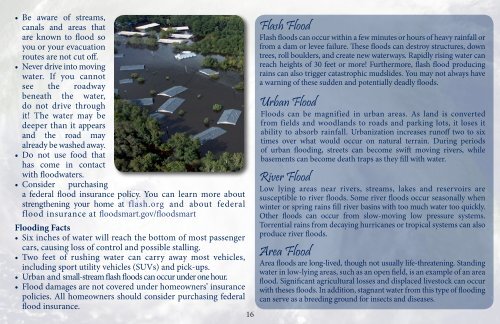2015 Guide
2015 Guide
2015 Guide
Create successful ePaper yourself
Turn your PDF publications into a flip-book with our unique Google optimized e-Paper software.
• Be aware of streams,<br />
canals and areas that<br />
are known to flood so<br />
you or your evacuation<br />
routes are not cut off.<br />
• Never drive into moving<br />
water. If you cannot<br />
see the roadway<br />
beneath the water,<br />
do not drive through<br />
it! The water may be<br />
deeper than it appears<br />
and the road may<br />
already be washed away.<br />
• Do not use food that<br />
has come in contact<br />
with floodwaters.<br />
• Consider purchasing<br />
a federal flood insurance policy. You can learn more about<br />
strengthening your home at flash.org and about federal<br />
flood insurance at floodsmart.gov/floodsmart<br />
Flooding Facts<br />
• Six inches of water will reach the bottom of most passenger<br />
cars, causing loss of control and possible stalling.<br />
• Two feet of rushing water can carry away most vehicles,<br />
including sport utility vehicles (SUVs) and pick-ups.<br />
• Urban and small-stream flash floods can occur under one hour.<br />
• Flood damages are not covered under homeowners’ insurance<br />
policies. All homeowners should consider purchasing federal<br />
flood insurance.<br />
16<br />
Flash Flood<br />
Flash floods can occur within a few minutes or hours of heavy rainfall or<br />
from a dam or levee failure. These floods can destroy structures, down<br />
trees, roll boulders, and create new waterways. Rapidly rising water can<br />
reach heights of 30 feet or more! Furthermore, flash flood producing<br />
rains can also trigger catastrophic mudslides. You may not always have<br />
a warning of these sudden and potentially deadly floods.<br />
Urban Flood<br />
Floods can be magnified in urban areas. As land is converted<br />
from fields and woodlands to roads and parking lots, it loses it<br />
ability to absorb rainfall. Urbanization increases runoff two to six<br />
times over what would occur on natural terrain. During periods<br />
of urban flooding, streets can become swift moving rivers, while<br />
basements can become death traps as they fill with water.<br />
River Flood<br />
Low lying areas near rivers, streams, lakes and reservoirs are<br />
susceptible to river floods. Some river floods occur seasonally when<br />
winter or spring rains fill river basins with too much water too quickly.<br />
Other floods can occur from slow-moving low pressure systems.<br />
Torrential rains from decaying hurricanes or tropical systems can also<br />
produce river floods.<br />
Area Flood<br />
Area floods are long-lived, though not usually life-threatening. Standing<br />
water in low-lying areas, such as an open field, is an example of an area<br />
flood. Significant agricultural losses and displaced livestock can occur<br />
with theses floods. In addition, stagnant water from this type of flooding<br />
can serve as a breeding ground for insects and diseases.


